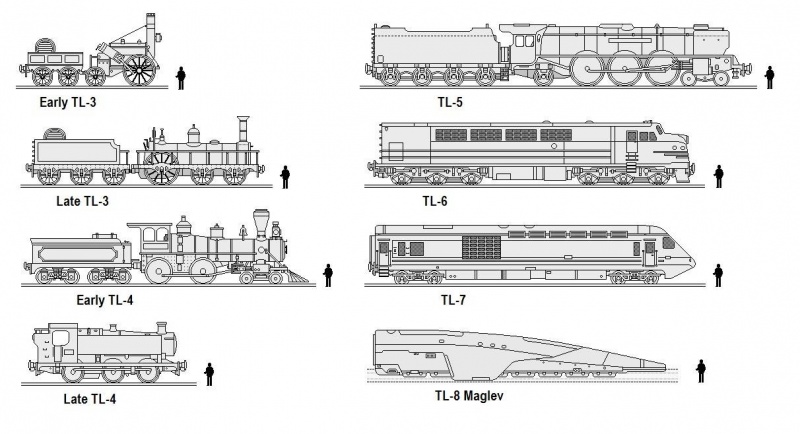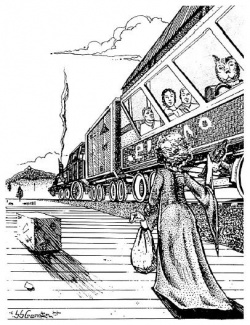Train
A Train is a kind of composite vehicle often used for mass transit of passengers and/or cargo.
- It is a type of civilian vehicle and is usually a groundcraft.
- On many worlds, they are an important part of transportation infrastructure.
- While many sophonts picture rains as a wheeled and rail technology, many other variants are possible including rubberized tires (...Land Trains), cable-pulley systems (...cable cars, funiculars, etc.), trackless trains, pressurized air systems (...Atmospheric Trains), trams, trolleys, monorails, maglev systems, and even later: the Grav Train.
Description (Specifications)
A train is a form of transport consisting of a series of connected vehicles that generally runs along a prepared path or track to transport cargo or passengers. The word "train" comes from the Old Terran French trahiner, derived from the Latin trahere meaning "to pull" or "to draw."
- Because a vast variety of forms of transportation exists within Charted Space, the generic term "train" is used to define two or more linked vehicles operating on a defined guideway in order to transport cargo or passengers between locations. Terms such as railroad, monorail or maglev are names for specific types of train.
- Trains normally require a guideway of the correct gauge and format to operate. This most commonly consists of paired parallel rails but may instead be based on a central beam, tunnel systems, pressurized tubes, cables, guide beacons or other variant systems.
Image Repository
- Trains are an important part of transportation infrastructure on many worlds. A variety of Terran-style locomotives are depicted: other worlds and cultures produce their own unique styles of rolling stock.

Common Types of Transportation Networks
- Land Trains: Linked Ground Vehicles (Usually Wheeled Vehicles) following a set route such as a paved highway.
- Railroad Trains: Linked Wheeled Rail Vehicles following a network made up of parallel rails.
- Monorail Trains: Linked Wheeled Rail Vehicles following a network made up from a single rail.
- Maglev Trains: Linked Mag-Lev Rail Vehicles following a network typically made up of a central beam containing equipment.
- Gravlev Networks: Linked Gravitic Rail Vehicles, typically employing early lifter technology capable of lifting a vehicle a few meters above the ground and utilizing flat, smooth prepared routes to maximize speed and efficiency.
- Hyperloop Systems: Linked pressurized Rail Vehicles operating within vacuum tubes.
- Skytrains: Linked Aircraft, Airships or Gravcraft, often following a set route between emplaced markers.
Technological Level
The listed technological level is the lowest at which the particular type of train is estimated to be efficiently constructed. Similar trains built at a higher technological level are more efficient, are likely to be constructed from more advanced materials, and may have an improved performance. They may also include improved items of onboard equipment such as upgraded environmental systems. Often a higher technology design exists which directly supersedes a similar but less advanced version.
Mainworld Design Considerations
Trains designed and built on a world generally only function on that one world. If they are transported to other worlds they will generally perform far below their normal parameters, often with catastrophic consequences. For example, air-breathing internal combustion power plants designed on a world with a standard atmosphere will struggle in thin atmospheres and may suffer internal damage if operated in dense atmospheres.
- Trains designed to work in higher gravity environments may have bizarre handling properties in lower gravity, and trains designed to operate in low gravity may struggle to perform at all in higher gravity environments.
Environmental Engineering Conversions
Trains designed to operate on one world may be modified to allow them perform more efficiently on other worlds.
A huge industry exists offering such conversions. Skilled mechanics change components designed to utilize atmospheric gases and upgrade or replace fuel and exhaust systems. Adjustments are made to transmission, suspension and braking systems, ballast is added or excess weight is removed, and power plants are tweaked, retuned or even entirely rebuilt. These modifications and conversions allow the train to operate relatively efficiently and safely within its new environmental conditions.
History & Background (Dossier)
Trains tend to be a pillar of transportation infrastructure for sophont societies during the TL:1-9 Foundational Period or Ur-Period of development. By TL:10-12, the conventional groundcraft technology becomes increasing supplanted and replaced by gravcraft. Grav trains are a viable technology and some societies have developed the technology viably.
Expected Train Development Sequence
MACRO LEVEL: TL:1-9:
- Network Type: Land Train → Railroad Train → Monorail Train → Funicular Train → Subway Train → Atmospheric Train → Hover Train → Maglev Train
- Motive Power: Steam Locomotive → Cog Locomotive → Light Rail Locomotive → Internal Combustion Locomotive → Diesel Locomotive → Electric Locomotive → High Speed Locomotive
MACRO LEVEL: TL:10-18
Foundational Age Societies
The first trains generally run on rails, tracks, roads, or prepared transit ways.
| Technological Period: TL:1-9 and Tech-Name: Ur-Tech | ||
|---|---|---|
| Common Characteristics: TBD, etc. | ||
| Tech Epoch | TL-Range | Remarks |
| Tool Making Epoch | TL:1-3 | During the end of this period, many sophont societies develop external combustion and the first viable, high beastpower power plants, which in turn leads to the development the first steam engines. Combined with metallurgy skills, rails and large engines can be cast, which result in continental train networks where resources are available. |
| Division of Labor Epoch | TL:4-6 | Increasing mastery of internal combustion engines result in more powerful diesel trains which can easily make transcontinental freight runs. Intermodal cargo systems increase the reach and flexibility of cargo networks. Land Trains and even Hover Trains on some worlds become viable. Most large bodies of water are dominated by maritime shipping options. |
| Processor Epoch | TL:7-9 | Electronics and electric trains become increasing more capable and superconductor and early gravitic control technology allow high speed trains, Maglev and even Gravlev movers. Lower aircraft fuel costs and competing mass transit systems begin to decrease the reach and desirability of train systems. |
Interstellar Age Societies
Gravitic trains have little to no need for preprepared infrastructure.
| Technological Period: TL:10-18 and Tech-Name: Stell-Tech | ||
|---|---|---|
| Common Characteristics: Typically used on higher technology worlds trying to diminish the ecological footprint. Often used alongside Fusion Plus, Arcologies, Traffic Nets, City Minds, etc. | ||
| Tech Epoch | TL-Range | Remarks |
| Gravitics Epoch | TL:10-12 | Mastery of gravity control technologies allow for the first grav trains, which begin to supplement earlier electro-mechanical technologies on worlds that can afford them. City Minds, AI controllers, allow city and even continent-wide traffic networks, with very low accident rates. |
| Biologicals Epoch | TL:13-15 | Fewer and fewer cities build widespread transportation infrastructure networks and the cost of gravcraft decreases. Within arcologies, people movers and internal mass transit networks are quite common. Grav trains still serve a very useful and valued place on such worlds, connecting arcologies. |
| Artificials Epoch | TL:16-18 | No one knows where the future will go with mass transit. Some cities have posited that planetwide gravitic control networks will become possible rather than a combination of continental travel networks supplemented by air/rafts, G-carriers, and Grav Trains. |
References & Contributors (Sources)
| This page uses content from Wikipedia. The original article was at Train. The list of authors can be seen in the page history. The text of Wikipedia is available under the Commons Attribution-ShareAlike 3.0 Unported License. |
| This article is missing content for one or more detailed sections. Additional details are required to complete the article. You can help the Traveller Wiki by expanding it. |
- Traveller Wiki Editorial Team
- Author & Contributor: Lord (Marquis) and Master Scout Emeritus Adie Alegoric Stewart of the IISS
- Author & Contributor: Lord (Marquis) and Master of Sophontology Maksim-Smelchak of the Ministry of Science
